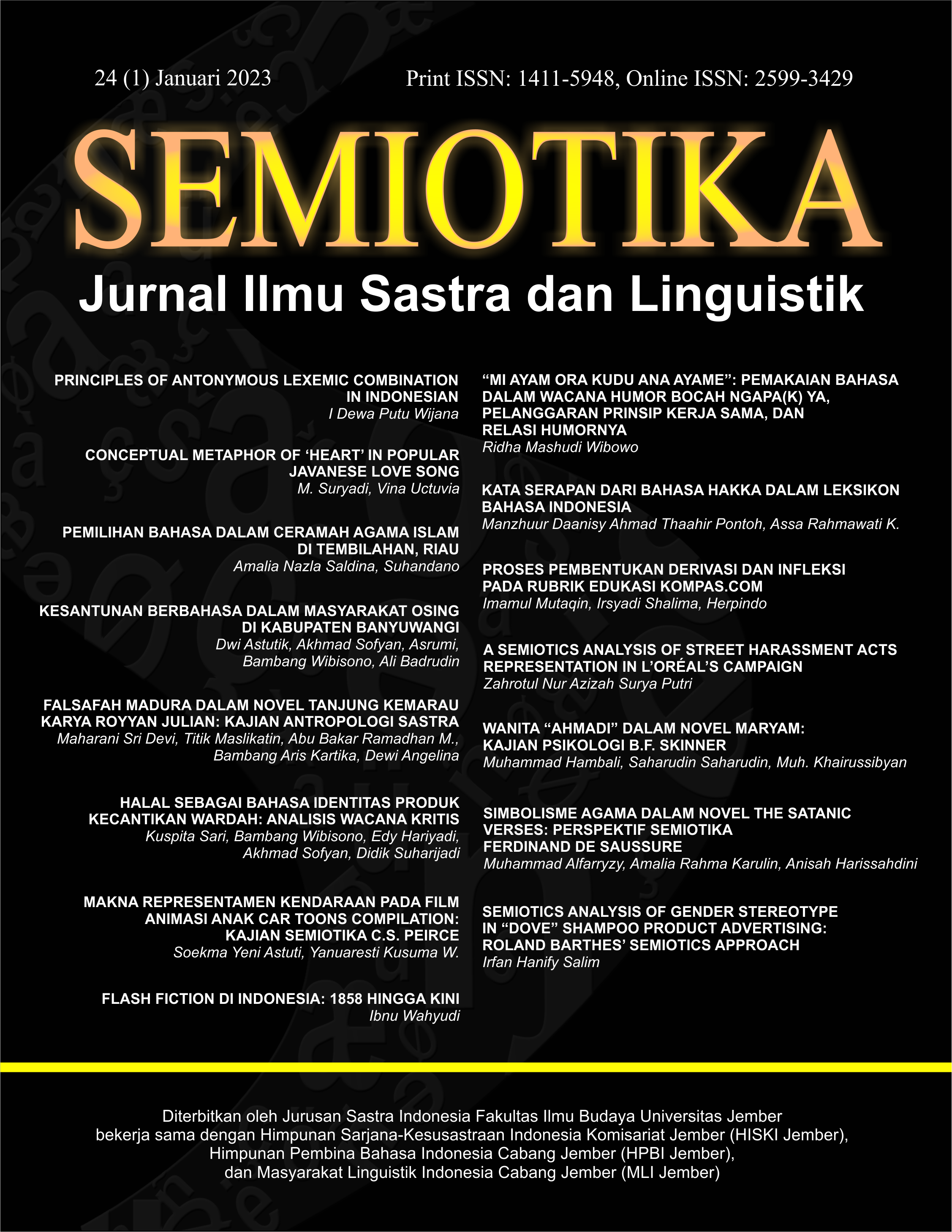SEMIOTICS ANALYSIS OF GENDER STEREOTYPE IN “DOVE” SHAMPOO PRODUCT ADVERTISING: ROLAND BARTHES’ SEMIOTICS APPROACH
Abstract
This study aims to analyze how stereotypes of women are represented in Dove shampoo advertisements and to analyze the semiotics of gender stereotypes in “Dove” shampoo product advertising using Roland Barthes’ semiotics approach. This study uses a qualitative method by taking primary data sourced from online media ‘YouTube’. The data source is in the form of advertisements for Dove shampoo products in 2022. The advertisement entitled “My Hair is My Crown (Rambutku Mahkotaku) - Dian Sastrowardoyo & Other Women’s Stories About HairBullying”. While the data analysis technique in this study was carried out by identifying signs according to the stages proposed by Roland Barthes (Roland Barthes’ semiotic theory) to determine the meaning of denotation and connotation of advertisements. The results of this study indicate that Dove shampoo advertisement analysis using the Barthes analysis model approach can be explained based on the analysis model by looking at the meaning of denotation and connotation. 5 hairstyles become the outline of the text that strengthens the purpose of depicting the ad including how the woman in the ad is depicted. In addition, each of the women with the 5 hairstyles had experienced hair-bullying because it did not fit the stereotypes of the society (Indonesian people). The five hairstyles are (1) straight hair (just straight), (2) short hair, (3) honeycomb hair, (4) colored hair, and (5) hijab. However, through the shampoo advertisement, Dove wanted to raise awareness about hair-bullying that women often face, through an anti-bullying song titled “My Hair is my Crown (Rambutku Mahkotaku)”. In more detail, Dove wanted to maintain women’s confidence in how to choose and express their hair and break down societal views and stereotypes about what is often considered “beautiful hair”.
References
Marketing Communications. Nelson Education.
Barker, C. 2000. Cultural Studies: Theory and Practice. London: Sage Publications.
Bloom, P. N., & Boone, L. N. 2006. Strategi Pemasaran Produk. Jakarta: Prestasi Pustaka
Raya.
Griffin, E. 2006. A First Look At Communication Theory. Boston: Mc Graw Hill Book
Company.
Hoed, B. 2014. Semiotik dan Dinamika Sosial Budaya. Depok: Komunitas Bambu.
Kasiyan. 2001. “Perempuan dan Iklan: Sebuah Catatan Tentang Patologi Gender Era Kapital”. Jurnal Deskomvis 3(2).
Machfoedz, M. 2010. Komunikasi Pemasaran Modern. Yogyakarta: Cakra Ilmu.
Martadi. 2001. “Citra Perempuan dalam Iklan di Majalah Femina Edisi Tahun 1999”. Jurnal
Deskomvis, 3(2).
Noor, F. & Wahyuningratna, R. N. 2017. “Representasi Sensualitas Perempuan dalam Iklan
New Era Boots di Televisi (Kajian Semiotika Roland Barthes)”. IKRAITHHUMANIORA, 1(2).
Rofidah, L. 2021. “Stereotip Gender di Media: Representasi Atlet Angkat Besi Perempuan pada
Drama Weightlifting Fairy Kim Bok Joo”. Jurnal Translitera, 10(2).
Sari, D. 2020. “Konstruksi Gender Perempuan Ideal dalam Iklan Sabun Lux Edisi Super Power:
Kajian Semiotika Roland Barthes. JSGA, 2(2).
Situmorang, B.R. 1999. Pemberitaan Kekerasan Terhadap Perempuan di Surat Kabar dalam
Media dan Gender: Perspektif Gender atas Industri Surat Kabar Indonesia.
Yogyakarta: LP3Y dan The Ford Foundation.
Sobur, A. 2012. Analisis Teks Media. Bandung: PT Remaja Rosdakarya.
Suharko. 1998. Budaya Konsumen dan Citra Perempuan dalam Media Massa dalam
Perempuan dan Media. Bandung: Remadja Rosda Karya.
Vera, Nawiroh. 2014. Semiotika dalam Riset Komunikasi. Bogor: Ghalia Indonesia.

This work is licensed under a Creative Commons Attribution-ShareAlike 4.0 International License.
SEMIOTIKA has CC-BY-SA or an equivalent license as the optimal license for the publication, distribution, use, and reuse of scholarly work. Authors who publish with this journal retain copyright and grant the journal right of first publication with the work simultaneously licensed under a Creative Commons Attribution-ShareAlike 4.0 International License that allows others to share the work with an acknowledgment of the work's authorship and initial publication in this journal.
Attribution-ShareAlike
CC BY-SA










